By Logan Gerken, Director of Project Development - Sports + Entertainment
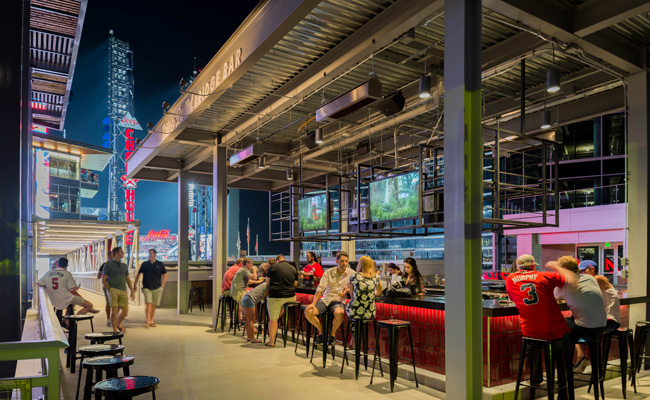
The era of the 100-yard-long sideline club is over. Nosebleed bleacher seating promoted as a low-cost entry point doesn’t cut it anymore. And the idea that an arena bowl can’t have any openings is being tested every year.
For the casual fan, the opportunity to attend a professional sports game is no longer a draw in itself. Teams are being challenged to rethink the way they do business in order to cater to a younger generation of fans who have an infinite number of entertainment options at their fingertips. Millennials are constantly seeking out unique, Instagram- and Snapchat-worthy experiences that capture their increasingly fragmented attention span and keep them engaged. No longer satisfied with simply taking in a game from general admission seats, today’s fans are drawn to intimate and informal gathering spaces that are adjacent to the action, rather than focused on it. They are looking for technology-rich environments where they can customize their individual experience from ticketing to food and beverage to social media.
So how do professional sports teams keep up with these rapidly evolving expectations? From a sales perspective, they have found success in implementing new marketing strategies such as flexible season ticket packages, mobile apps and partnership activations. However, the more daunting question is how to physically adapt venues in a manner that capitalizes on these opportunities and delivers significant ROI.
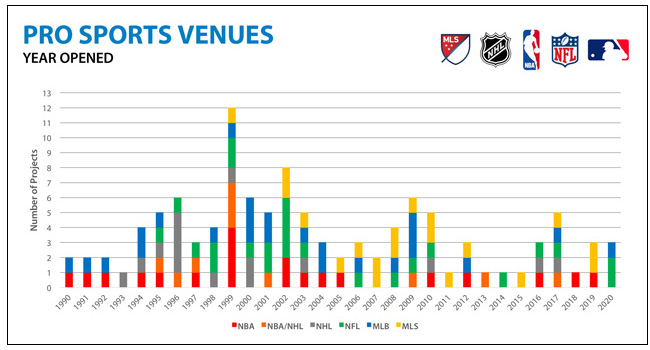
Today, approximately 60 percent of professional facilities in the five major sports leagues are more than 15 years old. Owners of these stadiums and arenas face impending obsolescence if they don’t continuously replace critical infrastructure and upgrade their amenities. The following framework offers three different approaches to modernization that provide significant value, yet offer a tiered approach that can be rightsized to a variety of conditions.
Pop-Ups
First rising to popularity on the art scene, pop-ups are now gaining momentum in sports venues across the country. Pop-ups are temporary, flexible and relatively low-cost retail activations that are designed to be easily set up and dismantled. This tactic can be used to refresh an existing space or to test a new partnership idea prior to scaling it for the masses. Pop-ups have been found to resonate with Millennials who looking for a “here today, gone tomorrow” one-of-a-kind experience.
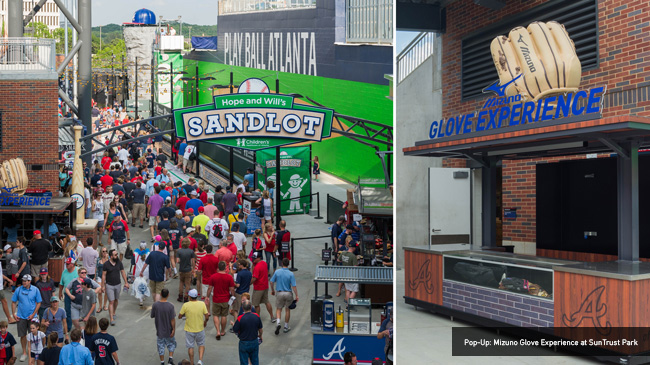
The Investment
- Planning: 3 – 6 months
- Construction: 2-4 months
- Cost: <$3M
Recent Applications
- SunTrust Park: Mizuno Glove Experience Kiosks – Located inside the ballpark, fans can pick out any style and size of glove to use for free during an Atlanta Braves game. This unique marketing channel allows customers to use the product in an authentic MLB environment. Fans are encouraged to visit the Mizuno Experience Center outside of the stadium after the game to purchase the same style of glove for a discount.
- Staples Center: Lexus Courtside Club – This pop-up premium space is implemented exclusively for LA Clippers games to cater to VIP customers. The event-level club is reserved for court-side ticket holders and features a private entrance, full bar and high end buffet, and game consoles to keep children entertained during game breaks.
Trend Setter
A viable alternative for those who do not have the budget to support a complete facility overhaul, trend setting renovations generate buzz by creating completely new experiences or by adding more of an existing fan favorite. Typically completed during the offseason, venues often use this opportunity to convert existing seating products and other under-performing assets into high demand premium spaces. In recent years, supersized suites, field or courtside bars, and loge seating have all been successfully implemented by teams in search of greater ROI. In addition to creating new and unique spaces, trend setting renovations often cater to fan preferences by introducing local food and beverage options and improving mobile connectivity via DAS and/or Wi-Fi.
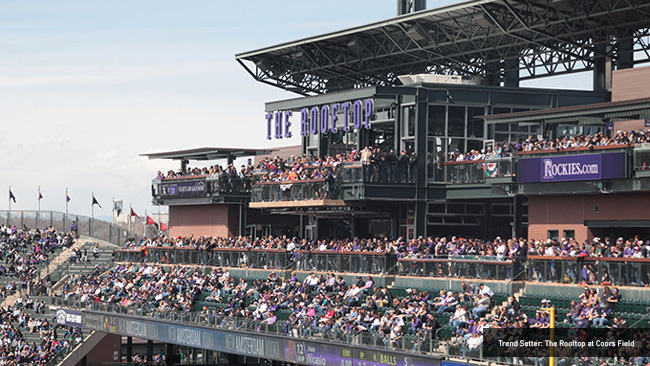
The Investment
- Planning: 8 – 12 months
- Construction: Single Off-Season
- Cost: $5M - $20M
Recent Applications
- Coors Field: The Rooftop – Looking to capitalize on the popularity of rooftop eateries in Denver’s Lower Downtown neighborhood, Coors Field created its own high elevation dining experience. Previously unused upper decks in right-center field were overhauled into a 38,000-square-foot, two-story party deck with multiple bars, covered seating areas and numerous drink rails.
- EverBank Field: Endzone Pool Cabanas – The Jacksonville Jaguars sought to attract a younger demographic with one of its newest premium offerings. The team removed 9,500 seats from its north end zone to create a two-story party deck that includes two pools and 16 cabanas. The pool-side suites accommodate 50 people and tickets include unlimited food and beverage.
- NRG Stadium: DAS Upgrade – In anticipation of record-breaking wireless data usage at Super Bowl LI, NRG Stadium bolstered its DAS system in 2016 to provide extra bandwith. More than 900 DAS antennas installed throughout the stadium ensure that fans have seamless access to social media as well as apps that support electronic ticketing, parking and in-seat concession ordering. The robust system also supports back-of-house operational functions and public safety.
Major Renovation
Major renovations are on the rise in professional sports, particularly in the NBA. In many cases, major renovations allow cities to retain the value of public funding that was previously invested in the existing facility, while also creating an opportunity to drastically improve the overall fan experience and create new revenue opportunities. These large scale projects touch virtually every element of a venue, allowing owners to add trend setting components as well as alleviate common operational pain points such as queuing, storage, marshalling, security and energy inefficiency.
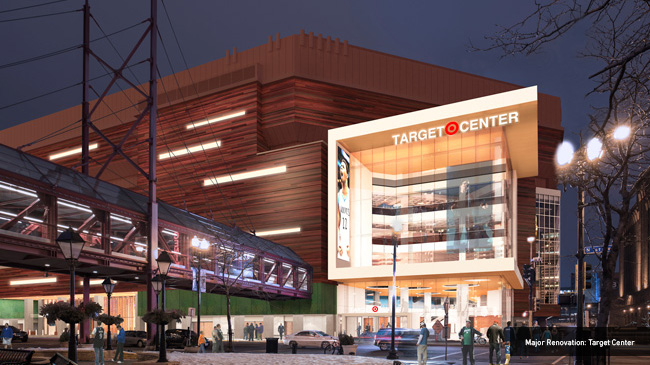
The Investment
- Planning: 12- 18 months
- Construction: 12 - 18 months
- Cost: >$150M
Recent Applications
- Target Center – Originally built in 1990, the 19,000-seat arena is wrapping up an extensive three-phase renovation that will extend the facility’s useful life by 30 years. The $140 million overhaul will add a signature façade and glass atrium, a new center-hung scoreboard, all new seats, upgraded suites and club spaces, improved Wi-Fi and modernized exterior and concourse areas.
- Philips Arena – The $192.5 million upgrade of Philips Arena is the second largest in NBA history. The project will add new amenities on every level of the facility such as a courtside bar, SWAG barbershop, Topgolf simulator suite, and celebrity-inspired restaurants. Fans will also enjoy a 360-degree connected course, improved sight lines and state-of-the-art video displays.
For some of the more involved trend setter options and certainly for major renovations, it is important to conduct an existing conditions assessment and a new market economic study. By baselining your current state, you will be able to better understand and communicate the need and the opportunity; no one wants to spend more on their venue’s infrastructure than required. This will also establish desired outcomes and set financial expectations for the project team, ensuring that decision making is ROI-focused and maximizes the fan experience. No matter your budget or time frame, there is an approach that will allow you to bring fresh new concepts to your fans.
Click here to learn more about Mortenson Sports + Entertainment.